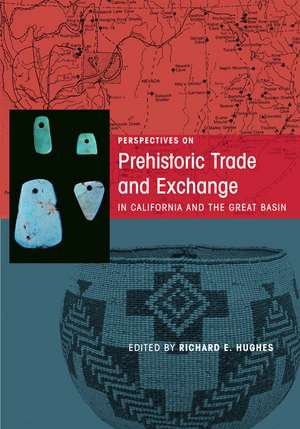Perspectives on Prehistoric Trade and Exchange in California and the Great Basin
Autor Richard E. Hughesen Limba Engleză Hardback – 30 dec 2011 – vârsta până la 80 ani
How does prehistoric material get from its place of origin to its location of archaeological recovery? While this question may seem basic, a moment’s reflection suggests that the answers carry important implications for arc-haeological interpretation about social organization, settlement, and subsistence practices. Archaeologists know much about the temporal and spatial distribution of materials in prehistoric western North America, but comparatively little has emerged regarding the causes of such distributions. Trade and exchange, mobility, and direct access all have been credited with observed distributions, but the reasons for settling on specific behavioral linkages is rarely made clear.
This volume investigates the circumstances and conditions under which trade/exchange, direct access, and/or mobility best account for material conveyance across varying distances at different times in the past. Each chapter contextualizes distributional and chemical data, evaluates competing distribution hypotheses, and addresses the reasoning and inferences employed to arrive at conclusions about the human behaviors responsible for the distributions of materials. Contributors showcase a range of diverse and creative ways of thinking about these issues in the California and Great Basin archaeological record, and why it matters.
This volume investigates the circumstances and conditions under which trade/exchange, direct access, and/or mobility best account for material conveyance across varying distances at different times in the past. Each chapter contextualizes distributional and chemical data, evaluates competing distribution hypotheses, and addresses the reasoning and inferences employed to arrive at conclusions about the human behaviors responsible for the distributions of materials. Contributors showcase a range of diverse and creative ways of thinking about these issues in the California and Great Basin archaeological record, and why it matters.
Preț: 350.47 lei
Preț vechi: 471.54 lei
-26% Nou
Puncte Express: 526
Preț estimativ în valută:
67.07€ • 68.69$ • 55.79£
67.07€ • 68.69$ • 55.79£
Carte indisponibilă temporar
Doresc să fiu notificat când acest titlu va fi disponibil:
Se trimite...
Preluare comenzi: 021 569.72.76
Specificații
ISBN-13: 9781607811527
ISBN-10: 1607811529
Pagini: 336
Ilustrații: 46 illus., 29 maps, 31 tables
Dimensiuni: 178 x 254 x 25 mm
Greutate: 0.8 kg
Ediția:1st Edition
Editura: University of Utah Press
Colecția University of Utah Press
ISBN-10: 1607811529
Pagini: 336
Ilustrații: 46 illus., 29 maps, 31 tables
Dimensiuni: 178 x 254 x 25 mm
Greutate: 0.8 kg
Ediția:1st Edition
Editura: University of Utah Press
Colecția University of Utah Press
Recenzii
“The idea for and concept behind the volume is innovative and timely.”
—Steven Simms, author of Traces of Fremont: Society and Rock Art in Ancient Utah (The University of Utah Press, 2010)
—Steven Simms, author of Traces of Fremont: Society and Rock Art in Ancient Utah (The University of Utah Press, 2010)
"An important volume that contributes significantly to our knowledge and understanding of Great Basin prehistory."
—Journal of Anthropological Research
—Journal of Anthropological Research
“Each chapter examines the problems and pitfalls of current methods of interpreting these data sources and proposes new and innovative ways of conducting analyses and questioning the archaeological record… This volume will help all of us think more critically about trade and exchange.”
—California Archaeology
—California Archaeology
Notă biografică
Richard E. Hughes is the director of the Geochemical Research Laboratory in California, and a research associate for the Division of Anthropology at the American Museum of Natural History and for the Archaeological Research Facility at the University of California, Berkeley.
Descriere
This volume investigates the circumstances and conditions under which trade/exchange, direct access, and/or mobility best account for material conveyance across varying distances at different times in the past.
